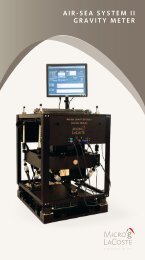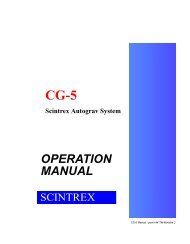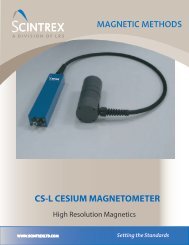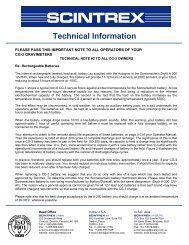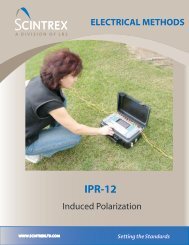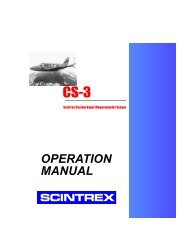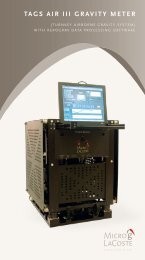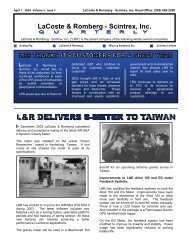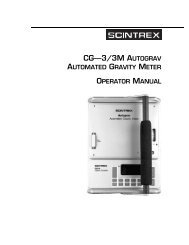CG-3 Description & Test Results - Scintrex
CG-3 Description & Test Results - Scintrex
CG-3 Description & Test Results - Scintrex
Create successful ePaper yourself
Turn your PDF publications into a flip-book with our unique Google optimized e-Paper software.
Protection from ambient temperature changes is provided by locating the quartz elastic system, theanalog to digital converter, sensitive electronic components and the tilt sensors inside a highstability,two stage, thermostatically controlled environment. There is no mechanical temperature compensation.External temperature changes are reduced by a factor of 105 and small residual effects are corrected insoftware using the output of a sensor located in close thermal contact with the main spring. Theoperating range of the thermostat in the standard instrument is –40°C to +45°C. However, as there is nocritical operating point for the sensor, the upper operating temperature can be set at a higher or lowervalue.The entire gravity sensing mechanism is enclosed in a vacuum chamber. As there are no mechanicalfeedthroughs, excellent isolation from variations in atmospheric pressure is obtained. This extremelystable operating environment for the quartz elastic system allows the longterm drift of the sensor to beaccurately predicted, and realtime software correction reduces it to less than 0.02 mGals/day.The sensor design is mechanically very simple for several reasons. The fine balancing required to obtainastatisation is not needed, as the displacement transducer has sufficient resolution (0.2nm) to detect thebeam position of a nonastatised system, and electronic filtering reduces the effect of seismic noise. Themechanisms, micrometer screws, gearboxes and mechanical feedthroughs associated with mechanicalfeedback systems have been replaced by a voltage applied to the same plates, which form thedisplacement transducer. The temperature control is also accurate enough for the sensor to operatewithout mechanical compensation.PackagingThe housing has been integrated with the carrying case (Fig. 2), so that one unit contains the sensor,supported by shockproof mounts, the data acquisition/control module, and the battery. This designreduces handling and therefore the danger of associated accidents of various kinds, such as upsetting theinstrument with the cable connecting the sensor to the battery. The dimensions are specifically designedto fit under an airline seat. The base of the gravity meter case incorporates a kinematic mounting systemwhich indexes onto the tripod, further increasing instrument stability.4



